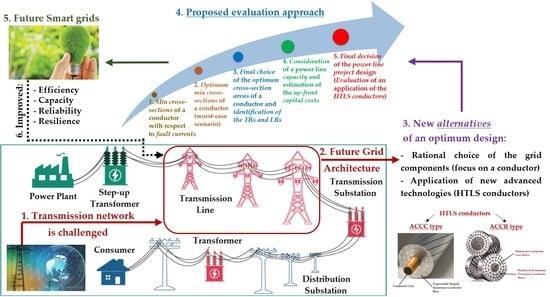Evaluation Study of Potential Use of Advanced Conductors in Transmission Line Projects †
Abstract
:1. Introduction
2. Design of Transmission Line
- The required throughput capacity is 600 A for a single circuit.
- The following climatic conditions in the TL route area are assumed: sun radiation, 850 W/m2; ambient temperature, +35 °C; wind velocity, 0.6 m/s, wind angle, 90°; elevation above sea level, 25 m (average value of the lowest conductor phase); emissivity factor, 0.5; absorptivity factor, 0.8; and load factor, 90%. Moreover, there are issues with the environmental conditions, such as conductor icing (galloping result), which can also impact the conductor selection. These are related to the mechanical limitation of the TL design in the particular areas. There were studies that considered the abovementioned issue, such as References [40,41,42].
3. Proposed Evaluation Approach
- (1)
- The required minimum cross-sectional area of a conductor must be calculated with respect to the fault current limitation. Calculations take into consideration the initial temperature of the advanced conductor using 11 temperature points starting from 150 °C to 50 °C, with 10 °C differences between points. Three estimated short-circuit currents, including the phase-to-ground short-circuit (Isc(1)), three-phase short-circuit (Isc(3)), and three times the zero-sequence current (3I0(1,1)) are taken as a basis for further computations of the cross-sectional areas of the conductor. The consideration of the abovementioned short-circuit currents represents the assumed thermal limitation of the conductor (the worst case), and it should be interrupted in less than 5 s (triggering distance protection) [44].
- (2)
- The required minimum cross-sectional area of a conductor must be identified with respect to the maximum short-circuit currents among the three presented and according to each initial conductor temperature. The worst-case scenario is considered (the necessity of a larger cross-section).
- (3)
- The common required minimum conductor cross-sectional areas must be selected with respect to the maximum short-circuit currents and with respect to each initial conductor temperature by revealing overlap regions.
- (4)
- Particular temperature regions (TR), as well as length regions (LR), must be set for the examined power line. The final choice is based on the common required minimum conductor cross-sectional area within the specified overlap regions.
- (5)
- The TL capacity must be estimated with respect to the specific design requirements of the OHL, as well as the up-front capital costs for both applied scenarios.
- (6)
- The obtained computation results for the up-front capital costs and the capacity of the TL must be evaluated with respect to the previously selected cross-sectional area of the conductor and its type for each examined temperature region (TR) and length region (LR).
4. Choice of Cross-Sectional Area of Conductor with Regard to Fault Current Limitation
4.1. Data on Short-Circuit Currents
- (a)
- “OHL No.1” had very high values for almost all short-circuit current types for the direction considered in Figure 2 (from “Substation A” toward “Substation B”) compared to the other direction in Figure 3. For example, the busbar of “Substation B” of “OHL No.1” (30th km) had 9.9 kA of Isc(3), followed by 7.5 kA of Isc(1), and 6.0 kA of 3I0(1,1). In addition, the maximum value of 3I0(1,1) was equal to 30.7 kA. However, the busbar of “Substation B” for the same “OHL No.1” in the other direction had 4.7 kA of Isc(3), 3.4 kA of Isc(1), and 2.7 kA of 3I0(1,1), and, in this case, Isc(3) had a maximum value of 12 kA.
- (b)
- For “OHL No.2”, when the busbar of “Substation B” was considered, almost the same values of short-circuit currents were observed compared to “OHL No.1” in both directions (see Figure 4 and Figure 5), but the maximum values differed. For instance, in the direction from “Substation C” toward “Substation B” in Figure 4, the maximum value of Isc(3) was equal to 10.3 kA, whereas, in the other direction (see Figure 5), it was 6.4 kA.
- (c)
- The fault current values changed depending on the position of the fault along the TL. The results show that, near the substation busbar (the extremity of the power line), the short-circuit currents were rather high, and the supply circuit was unbalanced compared to these values in the middle of the power line, when the supply circuit was practically balanced. The estimated short-circuit currents for “OHL No.1” especially justify these results. However, the obtained results for “OHL No.2” demonstrate a more balanced supply circuit along the whole length of the power line (the total length of “OHL No.2” was shorter than that of “OHL No.1”).
- (d)
- The results show that, basically, the worst case occurs when the three-phase short-circuit current appears (Isc(3); higher short-circuit current values), for both OHLs. At other times, the worst case occurs for three times the zero-sequence short-circuit current (3I0(1,1)), specifically for “OHL No.1” near the busbar of “Substation A” (up to the fourth km). However, practical TL operation shows that 3I0(1,1) rarely appears compared to a phase-to-ground short-circuit current (Isc(1)).
4.2. Calculations of Required Minimum Cross-Sectional Area of Conductor with Respect to Each Examined Short-Circuit Current
- S
- is the cross-sectional area in mm2;
- I1
- I2
- K
- is a constant in As1/2/mm2 that depends on the material of the current-carrying component, which, for aluminum, is taken to be 148 As1/2/mm2;
- β
- is the reciprocal in °C of the temperature coefficient of the resistance of the current-carrying component at 0 °C, which, for aluminum, is taken to be 228 °C;
- θf
- is the final temperature in °C, which is taken to be 175 °C because of the electrical strength limitation of the aluminum material (with some reserve in terms of reliability);
- θi
- is the initial temperature in °C, where 11 temperature points were here considered from 150 °C to 50 °C with 10 °C differences between points.
- (a)
- The comparisons between the cross-sectional areas of the conductor in terms of the OHL length starting from a substation busbar and moving toward the next substation are presented in Table 3 for “OHL No.1” and Table 4 for “OHL No.2”. For instance, when the OHL length was 0–4 km and the phase-to-ground short-circuit (Isc(1)) was considered, the difference between these lengths (0 km and 4 km) in terms of the cross-sectional area of the conductor was 69.1% for “OHL No.1”; however, for “OHL No.2” at the same length range, the value was 30.9%. In another example, when the OHL length was 12–16 km and the three-phase short-circuit (Isc(3)) was considered, the differences between these lengths (12 km and 16 km) in terms of the cross-sectional area of the conductor were 14.8% for “OHL No.1” and 32.8% for “OHL No.2”.
- (b)
- The cross-sectional area analysis of “OHL No.1” shows that, for lengths of 0–8 km, the maximum difference of 84% was observed for 3I0(1,1), with the minimum of 32.1% for Isc(3); for lengths of 8–24 km, the maximum difference of 26% and the minimum difference of 5.3% were found for the same 3I0(1,1), and, for lengths of 24–30 km, the difference was relatively in the same range for all of the examined short-circuit currents (see Table 3).
- (c)
- The total length of “OHL No.2” was less (17 km) than that of “OHL No.1” (30 km). Therefore, the difference did not exceed 32%. For instance, for lengths of 0–4 km, the differences for all of the considered short-circuit currents were almost in the same range. However, for lengths of 4–12 km, the maximum difference of 14.4% was observed for 3I0(1,1), with the minimum of 3.9% for Isc(3); for lengths of 12–16 km, the maximum difference of 32.8% was observed for Isc(3), with the minimum of 26.8% for 3I0(1,1) (see Table 4).
- (d)
- Three times the zero-sequence current and the phase-to-ground short-circuit current had the highest differences in the cross-sectional areas of the conductor in terms of the TL length.
4.3. Selection of Required Minimum Cross-Sectional Area of Conductor with Respect to Maximum Short-Circuit Current among the Three Estimated
- (a)
- The selection of the cross-sectional area of a conductor was based mainly on the three-phase short-circuit current (Isc(3)) and three times the zero-sequence short-circuit current (3I0(1,1)) by considering the worst-case scenario, i.e., the maximum short-circuit current among the three considered for both OHLs.
- (b)
- The difference with respect to the initial temperature of a conductor (θi) and each length from the initial substation busbar toward another substation had the same range when considering the selected cross-sectional areas of the conductor (worst-case scenario). For instance, when the OHL length was 0–4 km, the difference between these lengths (0 km and 4 km) in terms of the considered cross-sectional area of the conductor was 54.5% for “OHL No.1”; however, for “OHL No.2” at the same length range, it was 32.0%. In another example, when the OHL length was 8–12 km, the differences between these lengths (8 km and 12 km) were 21.5% (“OHL No.1”) and 3.9% (“OHL No.2”).
- (c)
- The maximum difference was observed near the substation busbar, and was quite small—in the middle of the line for both cases. For example, the maximum difference of the cross-sectional area of the conductor was 54.5% for “OHL No.1” (between the zeroth km and fourth km, “Substation A” busbar), whereas, for “OHL No.2”, it was 32.9 % (between the 12th km and 16th km, “Substation B” busbar). The minimum difference was 7.5% for “OHL No.1” (between the 20th km and 24th km, close to the “Substation B” busbar), and the same was observed for “OHL No.2”, with a value of 3.9% (between the 12th km and 16th km, near the “Substation B” busbar).
4.4. Selection of Optimum Cross-Sectional Area of Conductor and Identification of Particular Temperature Regions (TRs) and Length Regions (LRs)
- (a)
- The largest cross-sectional areas for a conductor were found for the “OHL No.1” length from the zeroth to fourth km for all the examined initial temperatures of the conductor, where the difference in terms of the cross-sectional area of the conductor was 54.5%. There was no difference between the power line lengths from the fourth to the eighth km. However, a very high difference was observed from the eighth km to the 12th km, which was 52.7%. From the 12th km to the 30th km for the length of “OHL No.1”, there was almost no difference (only 3% from the 16th km to the 20th km).
- (b)
- A similar tendency was observed for “OHL No.2”. For instance, the difference in terms of the cross-sectional area of the conductor had the highest value from the zeroth to the fourth km, which was 32%. There was no difference between the power line lengths from the fourth km to the 12th km. However, from the 12th km to the 17th km for the length of “OHL No.2”, there was a very high difference, which was 28.5%.
- (1)
- For “OHL No.1”, four TRs and three LRs were applied as follows:
- -
- TR1, with an initial conductor temperature of 150–140 °C;
- -
- TR2: 140–120 °C;
- -
- TR3: 120–80 °C;
- -
- TR4: 80–50 °C;
- -
- LR1, which represents the line from “Substation A” between the zeroth km and fourth km (0–4 km);
- -
- LR2 (4–8 km);
- -
- LR3 (8–30 km), which means that “Substation B” was reached.
- (2)
- For “OHL No.2”, three TRs and three LRs were applied as follows:
- -
- TR1, with an initial conductor temperature of 150–130 °C;
- -
- TR2: 130–80 °C;
- -
- TR3: 80–50 °C;
- -
- LR1, which represents the line from “Substation C” between the zeroth km and fourth km (0–4 km);
- -
- LR2 (4–12 km);
- -
- LR3 (12–16 km), which means that “Substation B” was reached.
- (a)
- The minimum required cross-sectional area of a conductor of 240 mm2 should be selected when the initial temperature of the conductor is taken to be at TR1 (150–140 °C) for LR2 (4–8 km). At the same time, when the initial temperature of a conductor decreases, for example to TR3 (120–80 °C), a cross-sectional area of 120 mm2 should be selected for the same LR2 (see Table 6).
- (b)
- The cross-sectional area of a conductor of 150 mm2 should be selected when the initial temperature of the conductor is taken to be at TR1 (150–130 °C) for LR1 (0–4 km). When the initial temperature of the conductor decreases to TR2 (130–80 °C), a cross-sectional area of 120 mm2 should be selected for the same LR1 (see Table 7).
- (c)
- The final choice, which is based on the calculated cross-sectional areas of the conductor, might be not appropriate because of project requirements in terms of the capacity of the OHL. Therefore, it was done by applying larger cross-sections for the conductor compared to the estimated one (see Table 6 and Table 7). Because the comparison was performed for two types of advanced conductors, the closest nominal aluminum cross-sectional area was selected.
5. Results of Application of HTLS Conductors
- (a)
- Based on the minimum required cross-sectional area, the ACCC and ACCR types were both selected with larger or almost the same cross-sectional areas for the conductor. There were few cases where the cross-sectional area of the selected conductor was slightly lower than the estimated values. These selections could be justified by a location in the middle of the OHL for these conductors. Moreover, there is a low probability that the estimated short-circuit currents will reach their maximum values.
- (b)
- The ACCC type had a minimum cross-sectional area of 112.8 mm² (ACCC-115), and the ACCR type had an area of 131 mm² (Partridge). Advanced conductors with lower cross-sectional areas than those mentioned above are not manufactured or there was no justification to use them because of several technical restrictions.
- (c)
- All of the cross-sectional areas of the advanced conductor types were selected as close as possible to the estimated values for the minimum required cross-sectional area of a conductor.
- (d)
- For both OHLs, seven types of ACCCs and six types of ACCRs were selected based on the required cross-sectional area of a conductor along the entire power line and according to the estimation conditions.
- (1)
- The capacity provided by the selected type of advanced conductor in the considered LR in terms of the initial conductor temperature, i.e., the TR;
- (2)
- The total up-front capital costs for the construction of a new OHL, as well as the reconstruction of the existing one under the assumed computation conditions.
5.1. Assessment of the Overhead Power Line Project Based on Throughput Capacity
- (a)
- The maximum difference between the throughput capacities was 7.4% when the initial conductor temperature was 140 °C (TR1) for LR3 (8–30 km), and the minimum of 0.7% was found for 50 °C (TR4) and LR1 (0–4 km). This difference had the tendency to decrease for all LRs of the TL when moving closer to the 30th km of “OHL No.1” (toward “Substation B”).
- (b)
- When “OHL No.2” was considered, the maximum difference was 25.1% for TR2 and all the LRs within it. However, the minimum of 0.7% was found TR3 and all the LRs. The cross-sectional area of the conductor was consistent within one TR, as explained above.
5.2. Assessment of Overhead Power Line Project Based on Total Up-Front Capital Costs
- I.
- Construction of a new OHL;
- II.
- Reconstruction of the existing one, basically by replacing the existing conventional conductor (ACSR) with the HTLSc.
- Ccc is the total up-front capital cost in euros (EUR);
- ∑Cm is the total material cost in EUR;
- ∑Ci is the total installation cost in EUR;
- ∑Coc represents the other costs in EUR.
- (a)
- If the new “OHL No.1” is constructed, the project with the ACCC type had a maximum effect of 17% and a minimum of 4% of the conductor on the material cost. The project with the ACCR type had a maximum effect of 29% and a minimum of 7%. However, the effect of a tower on the material cost was quite high; for instance, the maximum effect was 89% with a minimum of 78% for the ACCC type, while the maximum was 86% with a minimum of 67% for the ACCR type). Moreover, the effect of the total impact on the total up-front capital costs of the conductor varied from 3.5% to 7.2%, and the effect of the tower varied from 38.4% to 40% for both conductor types. When considering construction of “OHL No.2”, a similar tendency was observed. For instance, the maximum effect of the conductor on the total material cost reached 12.9% with a minimum of 5.7%, while the maximum effect for the weight of the tower was 34.9% with a minimum of 38.2%.
- (b)
- In the case of the reconstruction of the existing power line, the effect of the conductor increased for both material and total up-front capital costs in contrast to the effect of the tower for the examined TLs. For example, the effect of the conductor on the total up-front capital costs varied from 29.4% to 47.1%, and the effect of the tower varied from 16.3% to 22.1% for both conductor types (“OHL No.1”). When “OHL No.2” was considered, the effect of the conductor on the total up-front capital costs varied from 9.0% to 19.4%, and the effect of the tower varied from 6.6% to 7.6%.
- (1)
- The maximum difference in the OHL project cost reached 4.4% for TR1, where the initial temperature of the conductor was 150 °C (worst-case scenario), and the minimum difference of 1.7% was found for TR4 (50 °C) in the case of the construction of a new OHL.
- (2)
- If the existing power line is reconstructed, the maximum difference will become 24.6% for the same TR1 for the new TL, and the minimum difference will be 9.2% for TR4 due to the higher impact of the conductor cost on the total up-front capital costs of the TL project.
- (3)
- The project with the ACCR type had the maximum up-front capital costs for TR1 (150 °C), but the maximum for the TR4 (50 °C) with the ACCC type. However, the minimums for both the ACCR and ACCC types were for TR4 (80 °C) in both examined scenarios.
- (1)
- If a new OHL is constructed, the maximum difference in the TL cost will reach 6.3% for TR3 (70 °C), and the minimum difference will be 1.8% for TR2 (120 °C).
- (2)
- However, for the second scenario, the maximum difference becomes 9.5% for the same TR1 as in the case of the construction of a new power line, and the minimum difference will be 2.8% for the same TR3.
6. Discussion and Conclusions
Funding
Conflicts of Interest
References
- Verseille, J.; Staschus, K. ENTSO-E and European TSO cooperation in operations, planning, and R&D. IEEE Power Energy Mag. 2015, 13, 21–29. [Google Scholar]
- Hinkel, P.; Ostermann, M.; Pluntke, H.; Raoofsheibani, D.; Wellssow, W.; Gies, A. Development of a 2025 operational Central European transmission system model to investigate grid restoration strategies. In Proceedings of the International ETG Congress, Bonn, Germany, 28–29 November 2017; pp. 1–6. [Google Scholar]
- Kariniotakis, G.; Martini, L.; Caerts, C.; Brunner, H.; Retiere, N. Challenges, innovative architectures and control strategies for future networks: The web-of-cells, fractal grids and other concepts. CIRED Open Access Proc. J. 2017, 2017, 2149–2152. [Google Scholar] [CrossRef]
- European Commission. Energy roadmap 2050. In Luxembourg: Publications Office of the European Union; European Commission: Brussels, Belgium, 2012; p. 20. ISBN 978-9-27921798-2. [Google Scholar] [CrossRef]
- Western Area Power Administration (WAPA). Transmission Enhancement Technology Report. In Upper Great Plains Region, Transmission System Planning; WAPA: Lakewood, CO, USA, 2002; p. 17. [Google Scholar]
- Buijs, P.; Bekaert, D.; Cole, S.; Hertem, D.V.; Belmans, R. Transmission investment problems in Europe: Going beyond standard solutions. Energy Policy 2011, 39, 1794–1801. [Google Scholar] [CrossRef]
- Public Service Commission of Wisconsin. Environmental Impacts on Transmission lines. 31p. Available online: https://psc.wi.gov/Documents/Brochures/Enviromental%20Impacts%20TL.pdf (accessed on 12 January 2019).
- Rosellón, J. Different approaches towards electricity transmission expansion. Rev. Netw. Econ. 2003, 2, 238–269. [Google Scholar] [CrossRef]
- Krishnan, V.K.; Ho, J.; Hobbs, B.; Liu, A.L.; Mccalley, J.; Shahidehpour, M.; Zheng, Q.P. Co-optimization of electricity transmission and generation resources for planning and policy analysis: Review of concepts and modeling approaches. Energy Syst. 2016, 7, 297–332. [Google Scholar] [CrossRef]
- Munoz, F.D.; Watson, J.P.; Hobbs, F. Optimizing your options: Extracting the full economic value of transmission when planning under uncertainty. Electr. J. 2015, 28, 26–38. [Google Scholar] [CrossRef]
- Dong, X.; Kang, C.; Zhang, N.; Yan, H.; Meng, J.; Niu, X.; Tian, X. Estimating life-cycle energy payback ratio of overhead transmission line toward low carbon development. J. Mod. Power Syst. Clean Energy 2015, 3, 123–130. [Google Scholar] [CrossRef]
- Tokombayev, A.; Heydt, G.T. HTLS Upgrades and payback for the economic operation improvement of power transmission systems. Electr. Power Compon. Syst. 2015, 43, 345–355. [Google Scholar] [CrossRef]
- Patel, H.B. Re-conductoring scenario & payback calculations of acsr moose and its equivalents conductors for 400 kV transmission line [thermal uprating]. Int. J. Adv. Eng. Res. Dev. 2015, 2, 1283–1290. [Google Scholar]
- Teegala, S.K.; Singal, S.K. Economic analysis of power transmission lines using interval mathematics. J. Electr. Eng. Technol. 2015, 10, 1471–1479. [Google Scholar] [CrossRef]
- Kiessling, F.; Nefzger, P.; Nolasco, J.F.; Kaintzyk, U. Overhead Power Lines: Planning, Design, Construction, 1st ed.; Springer: Berlin/Heidelberg, Germany; New York, NY, USA, 2003; pp. 195–228. ISBN 978-36-4205556-0. [Google Scholar]
- Varygina, A.O.; Savina, N.V. The influence of new functional properties of active-adaptive electrical networks on the correctness of selection and verification of conductor cross-sections by existing methods. In Proceedings of the IEEE International Multi-Conference on Industrial Engineering and Modern Technologies (FarEastCon), Vladivostok, Russia, 3–4 October 2018; pp. 1–5. [Google Scholar] [CrossRef]
- Beryozkina, S.; Petrichenko, L.; Sauhats, A.; Guseva, S.; Neimane, V. The stochastic approach for conductor selection in transmission line development projects. In Proceedings of the IEEE International Energy Conference (ENERGYCON), Cavtat, Croatia, 13–16 May 2014; pp. 557–564. [Google Scholar] [CrossRef]
- Beryozkina, S.; Petrichenko, L.; Sauhats, A.; Jankovskis, N. Overhead power line design in market conditions. In Proceedings of the IEEE 5th International Conference on Power Engineering, Energy and Electrical Drives (POWERENG), Riga, Latvia, 11–13 May 2015; pp. 278–282. [Google Scholar] [CrossRef]
- Sauhats, A.; Beryozkina, S.; Petrichenko, L.; Neimane, V. Stochastic optimization of power line design. In Proceedings of the IEEE PowerTech Conference, Eindhoven, The Netherlands, 29 June–2 July 2015; pp. 1–6. [Google Scholar] [CrossRef]
- Dama, D.; Muftic, D.; Vajeth, R. Conductor optimisation for overhead transmission lines. In Proceedings of the IEEE Power Engineering Society Inaugural Conference and Exposition, Durban, South Africa, 11–15 July 2005; pp. 410–416. [Google Scholar] [CrossRef]
- Vasconcelos, J.A.D.; Teixeira, D.A.; Ribeiro, M.F.D.O. Optimal selection and arrangement of cables for compact overhead transmission lines of 138/230 kV. IEEE Latin Am. Trans. 2017, 15, 1460–1466. [Google Scholar] [CrossRef]
- CENELEC. Conductors for overhead lines. Round wire concentric lay stranded conductors; EN 50182: 2001/AC:2013; European Committee for Electrotechnical Standardization (CENELEC): Brussels, Belgium, August 2013; p. 78. [Google Scholar]
- Avdaković, S. Advanced Technologies, Systems, and Applications III, Proceedings of the International Symposium on Innovative and Interdisciplinary Applications of Advanced Technologies (IAT), Volume 1; Springer: Basel, Switzerland, 2019; pp. 187–197. ISBN 978-3-03-002573-1. [Google Scholar] [CrossRef]
- Kühnel, C.; Bardl, R.; Stengel, D.; Kiewitt, W.; Grossmann, S. Investigations on the mechanical and electrical behaviour of HTLS conductors by accelerated ageing tests. CIRED Open Access Proc. J. 2017, 2017, 273–277. [Google Scholar] [CrossRef]
- De Paulis, F.; Olivieri, C.; Orlandi, A.; Giannuzzi, G.; Bassi, F.; Morandini, C.; Fiorucci, E.; Bucci, G. Exploring remote monitoring of degraded compression and bolted joints in HV power transmission lines. IEEE Trans. Power Deliv. 2016, 31, 2179–2187. [Google Scholar] [CrossRef]
- CTC Global Corporation. Engineering Transmission Lines with High Capacity Low Sag ACCC Conductors, 1st ed.; CTC Global: Irvine, CA, USA, 2011; pp. 17–18, 97–106. ISBN 978-0-61-557959-7. [Google Scholar]
- CTC Global Corporation. ACCC Conductor Installation Guidelines; WI-750-070; CTC Global: Irvine, CA, USA, 2017; 8p. [Google Scholar]
- Kwon, J.; Hedman, K.W. Transmission expansion planning model considering conductor thermal dynamics and high temperature low sag conductors. IET Gener. Transm. Distrib. 2015, 9, 2311–2318. [Google Scholar] [CrossRef]
- Da Silva, A.A.P.; Bezerra, J.M.B. A model for uprating transmission lines by using HTLS conductors. IEEE Trans. Power Deliv. 2011, 26, 2180–2188. [Google Scholar] [CrossRef]
- Beryozkina, S.; Sauhats, A. Research and simulation of overhead power line uprating using advanced conductors. In Proceedings of the 56th International Scientific Conference on Power and Electrical Engineering of Riga Technical University (RTUCON), Riga, Latvia, 14 October 2015; pp. 1–4. [Google Scholar] [CrossRef]
- Silva, A.A.P.; Bezerra, J.M.B. Applicability and limitations of ampacity models for HTLS conductors. Electr. Power Syst. Res. 2012, 93, 61–66. [Google Scholar] [CrossRef]
- Exposito, A.G.; Santos, J.R.; Romero, P.C. Planning and operational issues arising from the widespread use of HTLS conductors. IEEE Trans. Power Syst. 2007, 22, 1446–1455. [Google Scholar] [CrossRef]
- Albizu, I.; Mazon, A.J.; Valverde, V.; Buigues, G. Aspects to take into account in the application of mechanical calculation to high-temperature low-sag conductors. IET Gener. Transm. Distrib. 2010, 4, 631–640. [Google Scholar] [CrossRef]
- Agrawal, S.; Nigam, M.K. Lightning phenomena and its effect on transmission line. Recent Res. Sci. Technol. 2014, 6, 183–187. [Google Scholar]
- Panth, D. Reasons for failure of transmission lines and their prevention strategies. Int. J. Electr. Electron. Data Commun. 2014, 2, 1–4. [Google Scholar]
- Ratnamahilan, P.; Hoole, P.R.P. Modeling the lightning earth flash return stroke for studying its effects on engineering systems. IEEE Trans. Mag. 1993, 29, 1839–1844. [Google Scholar] [CrossRef]
- Electric Power Research Institute (EPRI). Demonstration of Advanced Conductors for Overhead Transmission Lines; EPRI: Palo Alto, CA, USA, 2008; p. 1017448. [Google Scholar]
- AST, The Kurzeme Ring. Available online: http://www.ast.lv/en/transmission-network-projects/kurzeme-ring (accessed on 12 January 2019).
- Baltic Energy Market Interconnection Plan (BEMIP), 6th Progress Report, July 2013–August 2014. p. 54. Available online: https://ec.europa.eu/energy/sites/ener/files/documents/20142711_6th_bemip_progress_report.pdf (accessed on 12 January 2019).
- Ma, G.; Li, C.; Quan, J.; Jiang, J.; Cheng, Y. A fiber Bragg grating tension and tilt sensor applied to icing monitoring on overhead transmission lines. IEEE Trans. Power Deliv. 2011, 26, 2163–2170. [Google Scholar] [CrossRef]
- Savadjiev, K.; Farzaneh, M. Modeling of icing and ice shedding on overhead power lines based on statistical analysis of meteorological data. IEEE Trans. Power Deliv. 2004, 19, 715–721. [Google Scholar] [CrossRef]
- Ma, G.-M.; Li, Y.-B.; Mao, N.-Q.; Shi, C.; Zhang, B.; Li, C.-R. A fiber Bragg grating based dynamic tension detection system for overhead transmission line galloping. Sensors 2018, 18, 365. [Google Scholar] [CrossRef] [PubMed]
- Power Line Systems. PLS-CADD—Version 13.2, User’s Manual. 2014, p. 540. Available online: http://www.powline.com/products/pls_cadd.html (accessed on 12 January 2019).
- CENELEC. Overhead Electrical Lines Exceeding AC 45 kV. Part 1: General Requirements—Common Specifications; EN 50341-1/A1; European Committee for Electrotechnical Standardization (CENELEC): Brussels, Belgium, July 2009; pp. 106–112. [Google Scholar]
- Lomane, T.; Rubcovs, S.; Kovalenko, S.; Berzina, K. The effectiveness increasing of earth fault distance protection operation in high-voltage cable line. In Proceedings of the 9th International Scientific Symposium on Electrical Power Engineering (ELEKTROENERGETIKA), Stara Lesna, Slovakia, 12–14 September 2017; pp. 378–383. [Google Scholar]
- Blackburn, J.L.; Domin, T.J. Protective Relaying: Principles and Applications, 4th ed.; Taylor & Francis Inc.: Boca Raton, FL, USA, 2014; 324p, ISBN 9781439888117. [Google Scholar]
- Gorur, R.; Mobasher, B.; Olsen, R. Characterization of Composite Cores for High Temperature-Low Sag (HTLS) Conductors (Final project report); Power Systems Engineering Research Center (PSERC): Tempe, AZ, USA, July 2009. [Google Scholar]
- Banerjee, K. Making the Case for High Temperature Low Sag (HTLS) Overhead Transmission Line Conductors. Master’s Thesis, Arizona State University, Tempe, AZ, USA, 2014. [Google Scholar]
- 3M Aluminum Conductor Composite Reinforced (ACCR). Available online: https://www.ieee.hr/_download/repository/Allan_Russell_3M_ACCR_%28Aluminum_Conductor_Composite_Reinforced%29_-_Proven_Solutions_to_Increase_Capacity.pdf (accessed on 12 January 2019).
- CTC Global’s High Performance Conductors for a Low Carbon World™. Available online: https://www.ctcglobal.com/?_vsrefdom=adwords&gclid=EAIaIQobChMIqvH_0Ifp3wIVxjLTCh3muA9XEAAYASAAEgK-0_D_BwE (accessed on 12 January 2019).
- ACCR Conductor. Available online: https://www.3m.com/3M/en_US/power-transmission-us/resources/accr-technical/ (accessed on 15 January 2019).
- ACCC Conductor. Available online: https://www.ctcglobal.com/accc-conductor/ (accessed on 9 January 2019).
- Yli-Hannuksela, J. The Transmission Line Cost Calculation. Ph.D. Thesis, Vaasan Ammattikorkeakoulu, University of Applied Sciences, Vaasan, Finland, 2011; pp. 36–41. [Google Scholar]
- Bryant, D. High cost vs. high performance. How a pricier product can save you money. Utility Prod. Mag. 2014, 11, 4. [Google Scholar]
- Glenmar, E. Cambri, 3M ACCR. More Amps—More Confidence, 2012, 9p. Available online: https://d2oc0ihd6a5bt.cloudfront.net/wp-content/uploads/sites/837/2015/06/HTLS-DDW-ADB-3M-ACCR-PreR11.pdf (accessed on 28 February 2019).

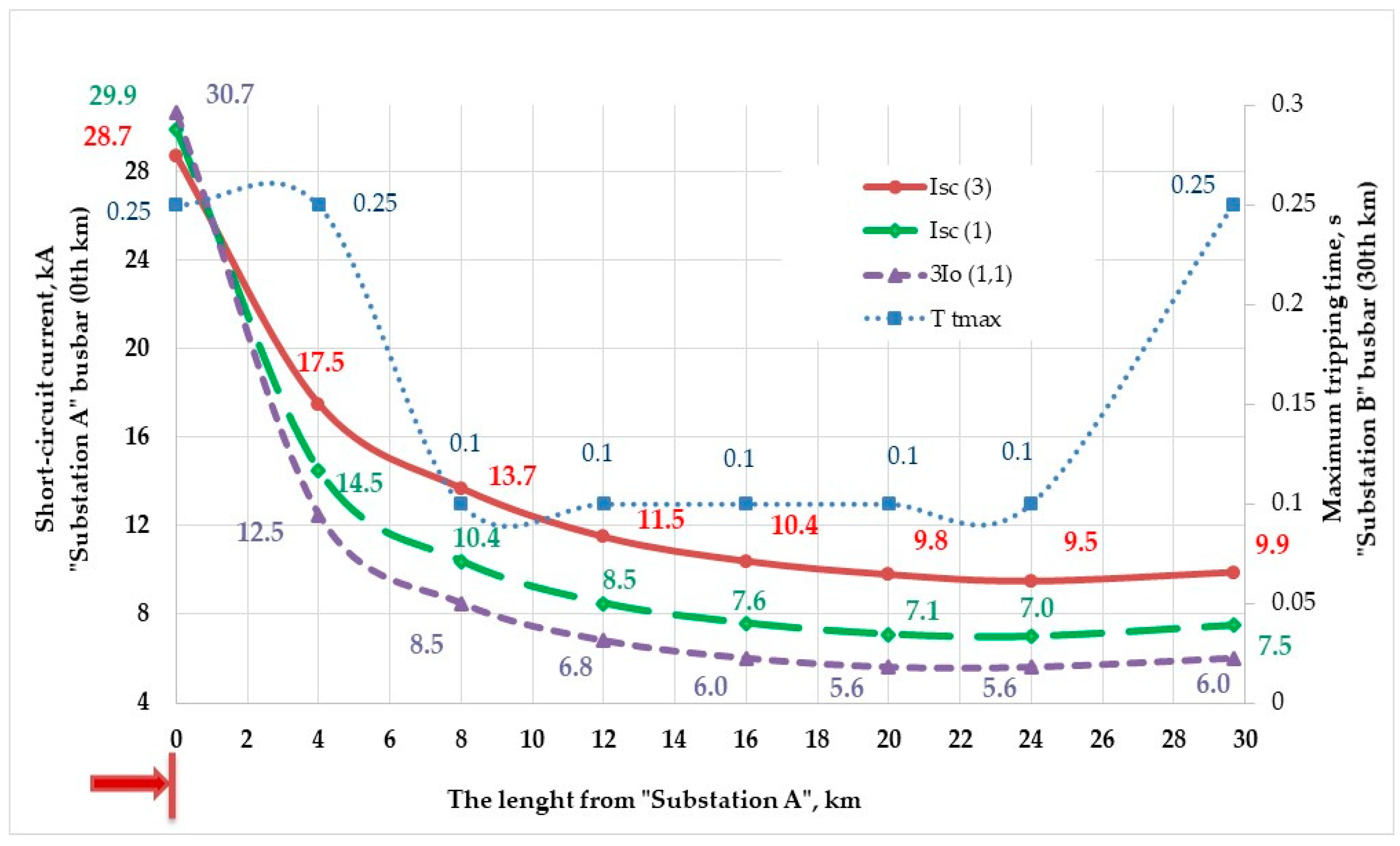
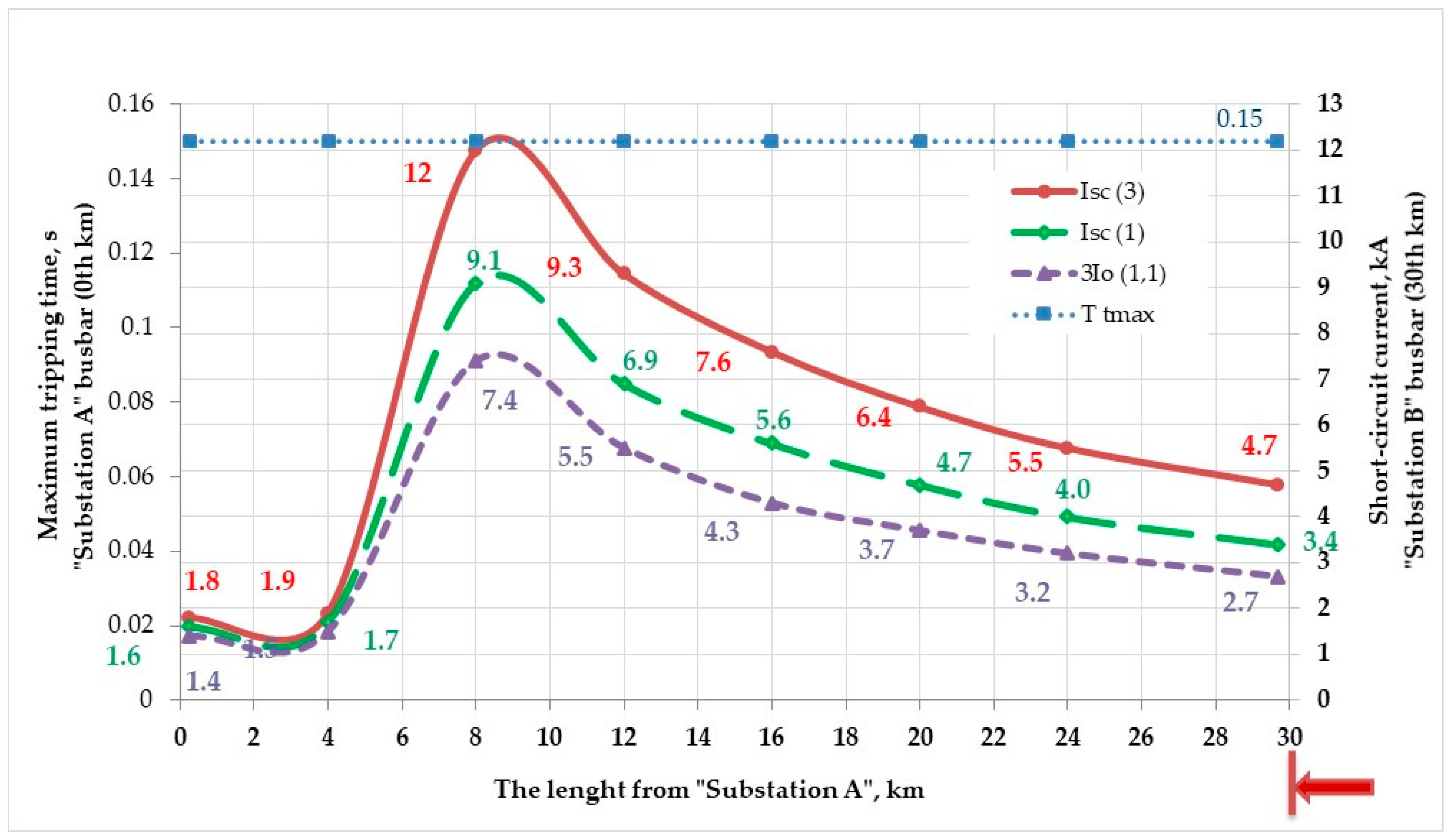
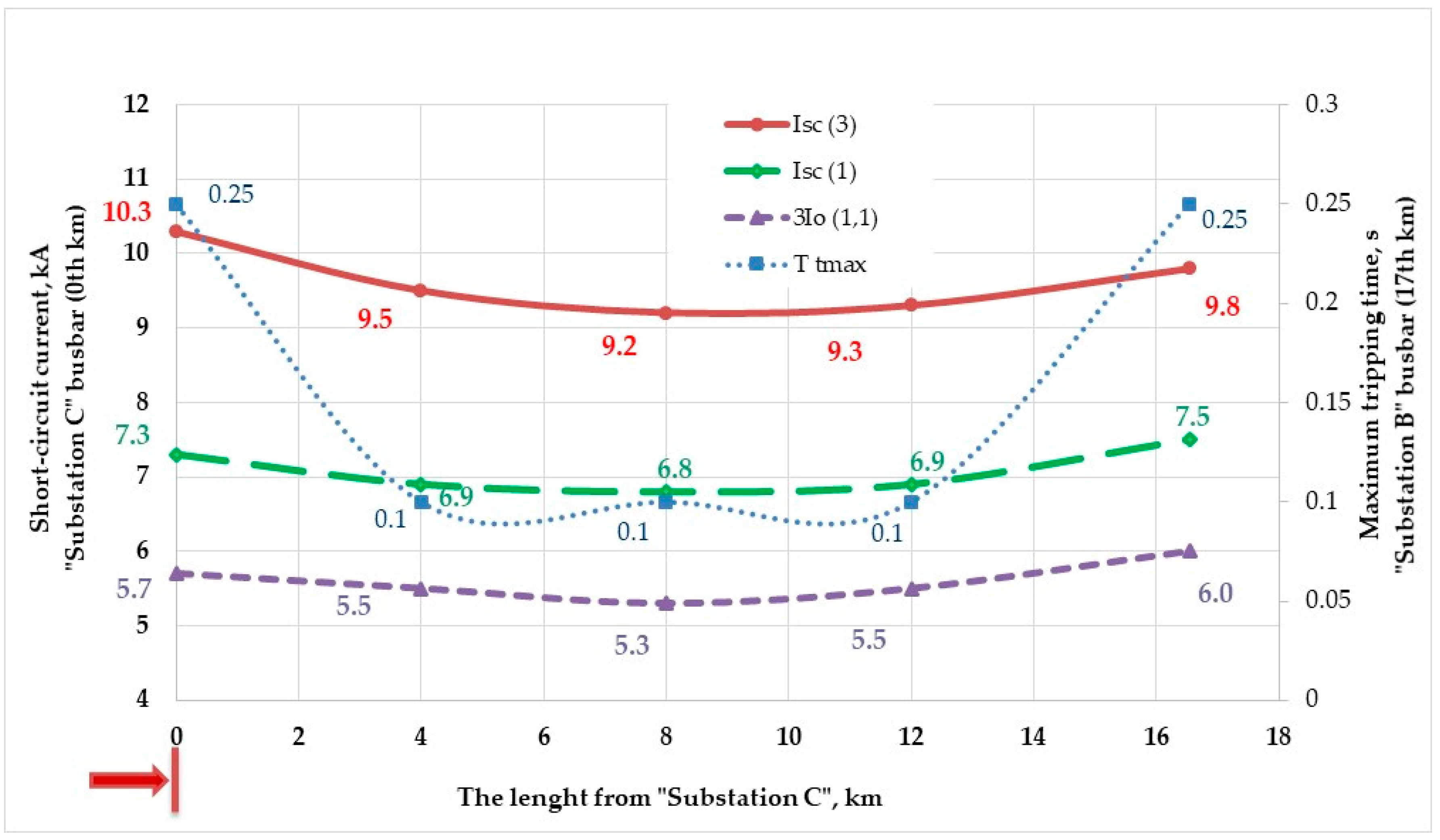



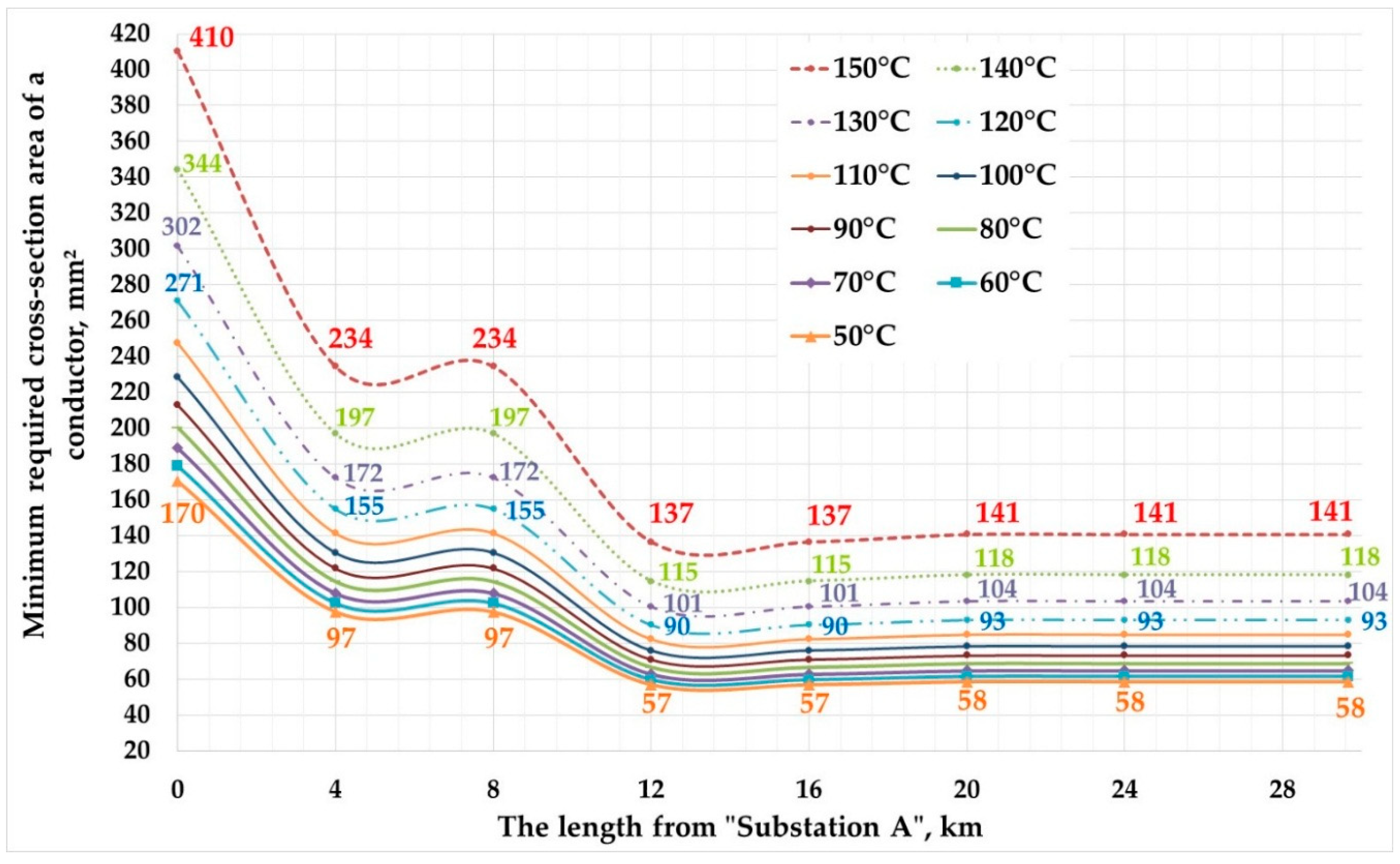
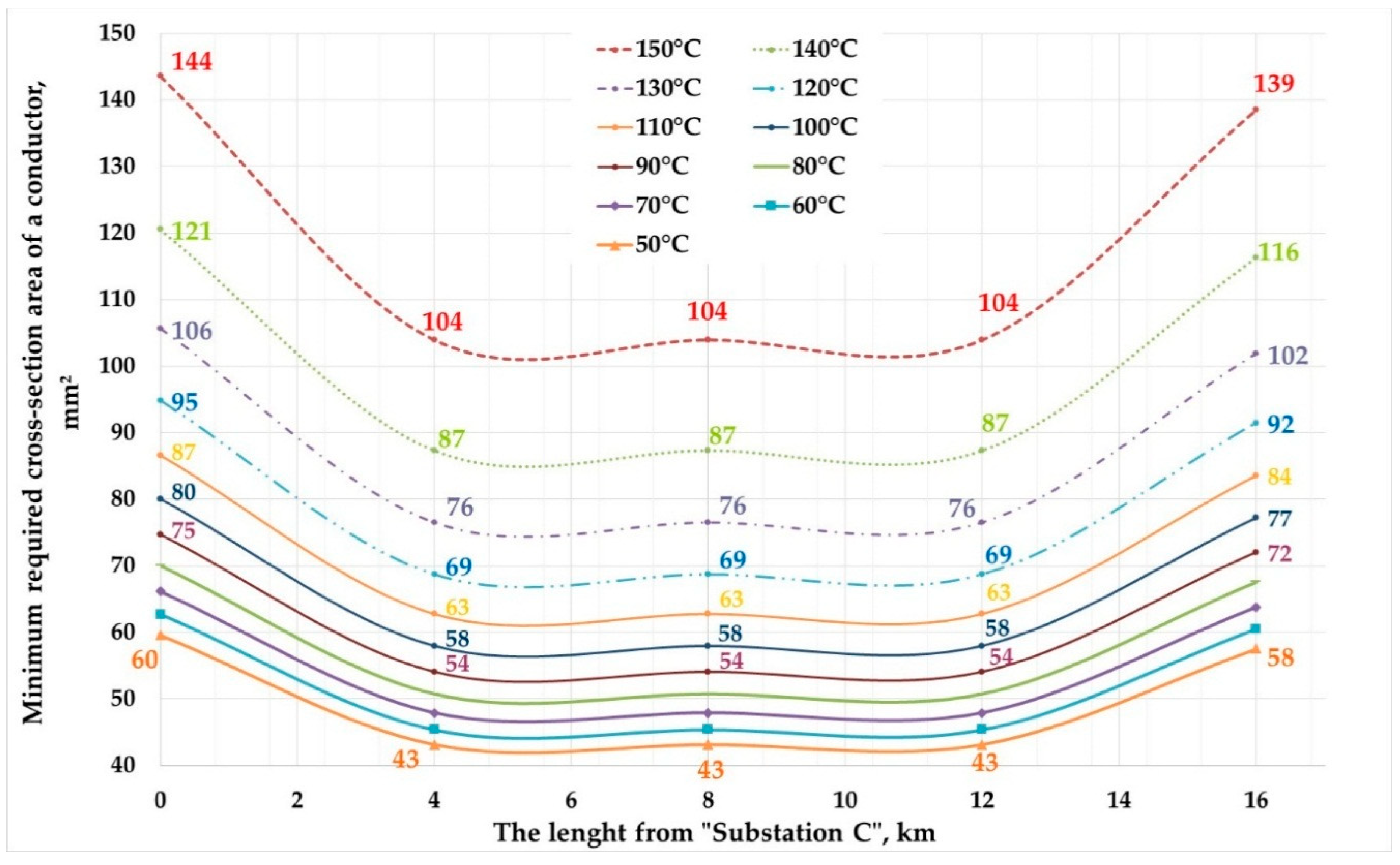
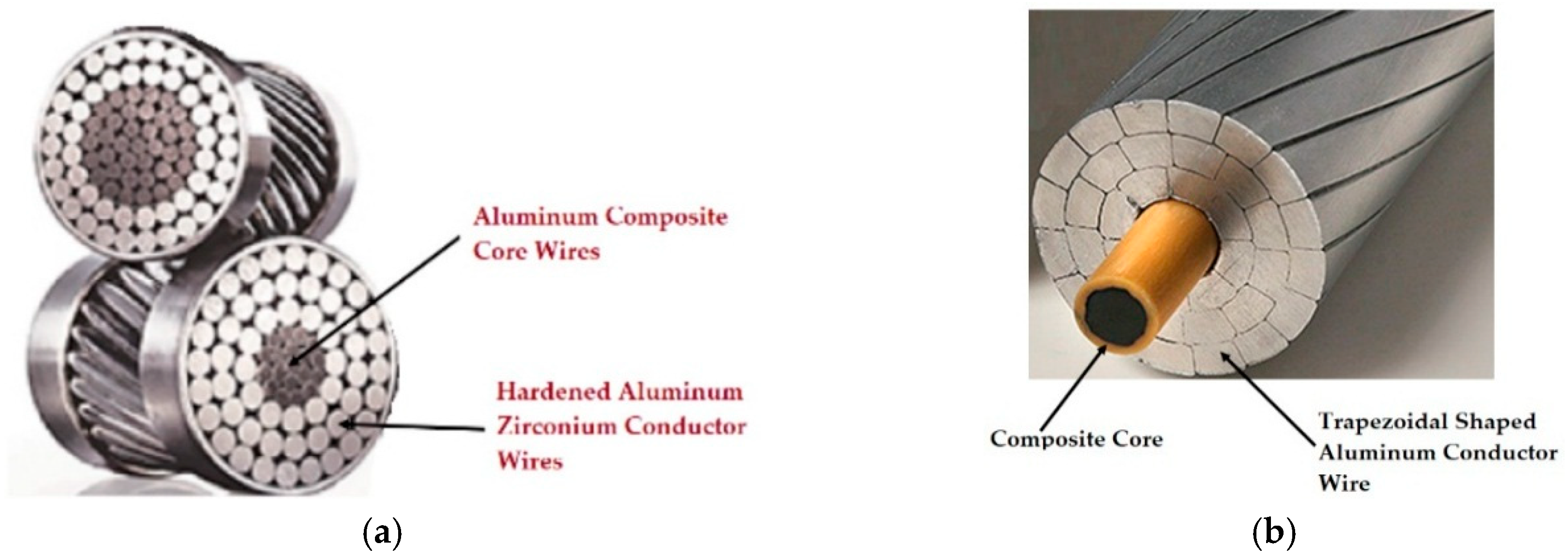

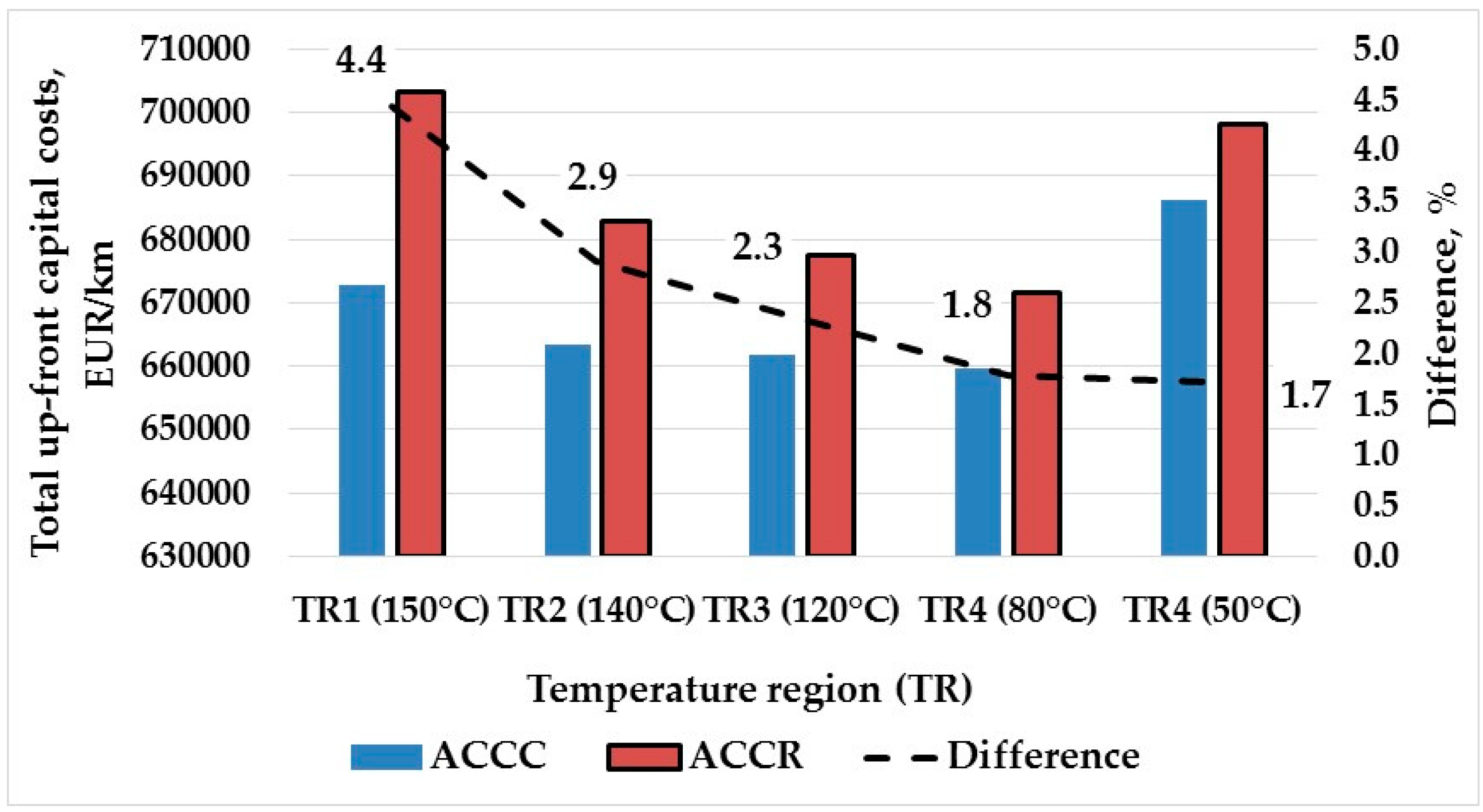

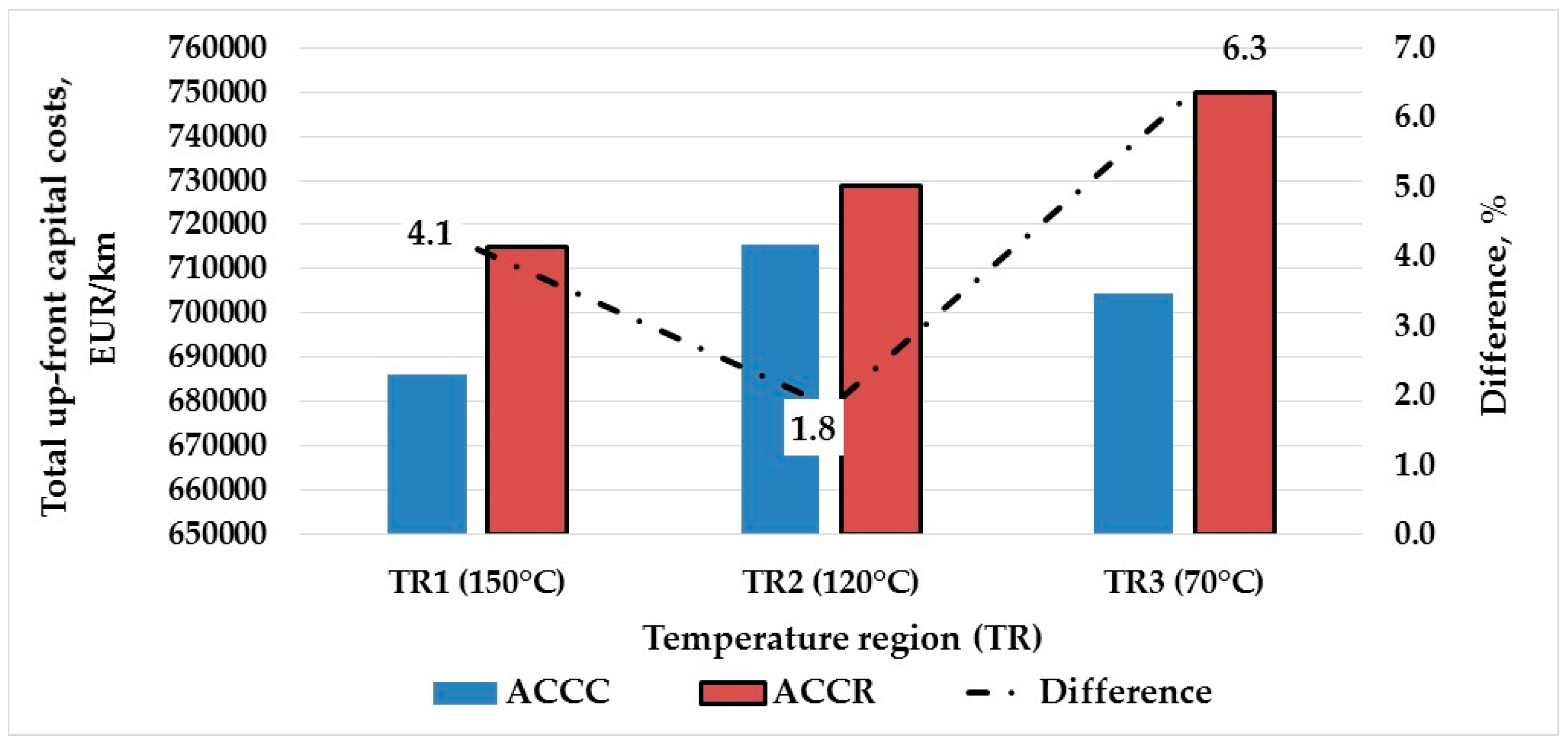
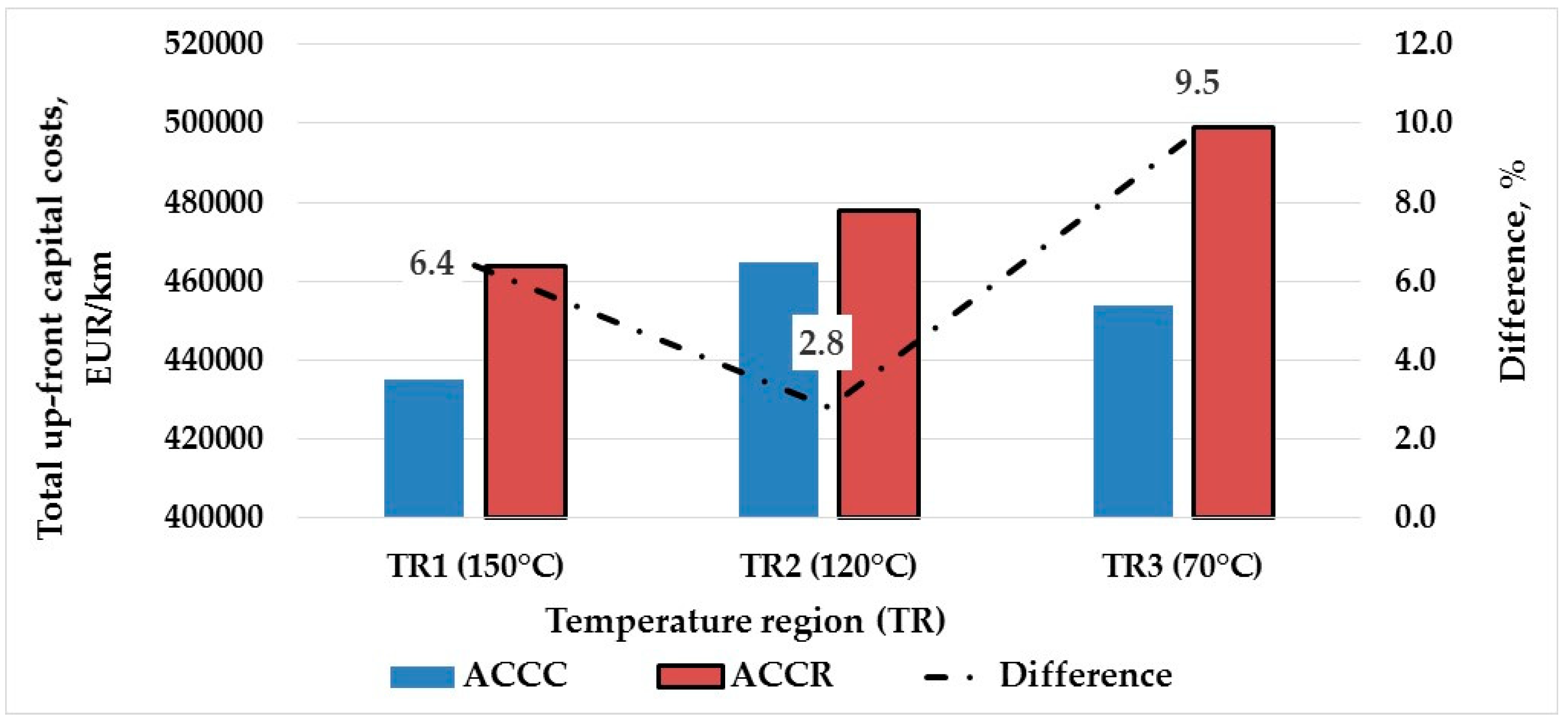
| θi, °C | Length from “Substation A”, km 1 | S for Isc(1), mm 2 | S for Isc(3), mm 2 | S for 3I0(1,1), mm 2 | θi, °C | Length from “Substation A”, km 2 | S for Isc(1), mm 2 | S for Isc(3), mm 2 | S for 3I0(1,1), mm 2 |
|---|---|---|---|---|---|---|---|---|---|
| 150 | 0 | 400 | 384 | 410 | 100 | 0 | 223 | 214 | 229 |
| 4 | 194 | 234 | 168 | 4 | 108 | 131 | 93 | ||
| 8 | 129 | 170 | 105 | 8 | 72 | 95 | 59 | ||
| 12 | 101 | 137 | 81 | 12 | 56 | 76 | 45 | ||
| 16 | 86 | 118 | 67 | 16 | 48 | 66 | 38 | ||
| 20 | 77 | 106 | 61 | 20 | 43 | 59 | 34 | ||
| 24 | 72 | 98 | 58 | 24 | 40 | 55 | 32 | ||
| 30 | 106 | 141 | 85 | 30 | 59 | 79 | 47 | ||
| 140 | 0 | 335 | 322 | 344 | 90 | 0 | 208 | 199 | 213 |
| 4 | 163 | 197 | 141 | 4 | 101 | 122 | 87 | ||
| 8 | 108 | 142 | 88 | 8 | 67 | 88 | 55 | ||
| 12 | 85 | 115 | 68 | 12 | 53 | 71 | 42 | ||
| 16 | 73 | 99 | 57 | 16 | 45 | 61 | 35 | ||
| 20 | 65 | 89 | 51 | 20 | 38 | 55 | 30 | ||
| 24 | 61 | 83 | 48 | 24 | 38 | 51 | 30 | ||
| 30 | 89 | 118 | 71 | 30 | 55 | 73 | 44 | ||
| 130 | 0 | 294 | 282 | 302 | 80 | 0 | 195 | 187 | 200 |
| 4 | 143 | 172 | 123 | 4 | 95 | 114 | 82 | ||
| 8 | 95 | 125 | 77 | 8 | 63 | 83 | 51 | ||
| 12 | 74 | 101 | 59 | 12 | 49 | 67 | 39 | ||
| 16 | 64 | 87 | 50 | 16 | 42 | 58 | 33 | ||
| 20 | 57 | 78 | 45 | 20 | 36 | 52 | 28 | ||
| 24 | 53 | 72 | 42 | 24 | 35 | 48 | 28 | ||
| 30 | 78 | 141 | 62 | 30 | 52 | 69 | 41 | ||
| 120 | 0 | 264 | 253 | 271 | 70 | 0 | 184 | 177 | 189 |
| 4 | 128 | 155 | 111 | 4 | 90 | 108 | 77 | ||
| 8 | 85 | 112 | 69 | 8 | 59 | 78 | 48 | ||
| 12 | 67 | 90 | 53 | 12 | 47 | 63 | 37 | ||
| 16 | 57 | 78 | 45 | 16 | 40 | 54 | 37 | ||
| 20 | 51 | 70 | 40 | 20 | 36 | 49 | 28 | ||
| 24 | 48 | 65 | 38 | 24 | 33 | 45 | 27 | ||
| 30 | 70 | 93 | 56 | 30 | 49 | 65 | 39 | ||
| 110 | 0 | 241 | 231 | 247 | 60 | 0 | 174 | 167 | 179 |
| 4 | 117 | 141 | 101 | 4 | 85 | 102 | 73 | ||
| 8 | 78 | 102 | 63 | 8 | 56 | 74 | 46 | ||
| 12 | 61 | 82 | 49 | 12 | 44 | 60 | 35 | ||
| 16 | 52 | 71 | 41 | 16 | 38 | 51 | 29 | ||
| 20 | 47 | 64 | 37 | 20 | 34 | 46 | 27 | ||
| 24 | 44 | 59 | 35 | 24 | 31 | 43 | 25 | ||
| 30 | 64 | 85 | 51 | 30 | 46 | 61 | 37 | ||
| 50 | 0 | 166 | 159 | 170 | 50 | 16 | 36 | 49 | 28 |
| 4 | 81 | 97 | 70 | 20 | 32 | 44 | 25 | ||
| 8 | 53 | 70 | 44 | 24 | 30 | 41 | 24 | ||
| 12 | 42 | 57 | 34 | 30 | 44 | 58 | 35 |
| θi, °C | Length from “Substation C”, km 1 | S for Isc(1), mm 2 | S for Isc(3), mm 2 | S for 3I0(1,1), mm 2 | θi, °C | Length from “Substation C”, km 2 | S for Isc(1), mm 2 | S for Isc(3), mm 2 | S for 3I0(1,1), mm 2 |
|---|---|---|---|---|---|---|---|---|---|
| 150 | 0 | 104 | 144 | 82 | 90 | 0 | 54 | 75 | 43 |
| 4 | 76 | 104 | 60 | 4 | 39 | 54 | 31 | ||
| 8 | 71 | 96 | 56 | 8 | 37 | 50 | 29 | ||
| 12 | 78 | 99 | 64 | 12 | 41 | 52 | 33 | ||
| 16 | 105 | 139 | 84 | 16 | 55 | 72 | 44 | ||
| 140 | 0 | 87 | 121 | 69 | 80 | 0 | 51 | 70 | 40 |
| 4 | 64 | 87 | 51 | 4 | 37 | 51 | 29 | ||
| 8 | 59 | 80 | 47 | 8 | 35 | 47 | 27 | ||
| 12 | 69 | 83 | 54 | 12 | 38 | 49 | 31 | ||
| 16 | 89 | 116 | 71 | 16 | 51 | 68 | 41 | ||
| 130 | 0 | 76 | 106 | 60 | 70 | 0 | 45 | 66 | 38 |
| 4 | 56 | 76 | 44 | 4 | 33 | 48 | 28 | ||
| 8 | 52 | 70 | 41 | 8 | 31 | 44 | 26 | ||
| 12 | 57 | 73 | 47 | 12 | 34 | 46 | 30 | ||
| 16 | 78 | 102 | 62 | 16 | 46 | 64 | 30 | ||
| 120 | 0 | 68 | 95 | 54 | 60 | 0 | 43 | 63 | 36 |
| 4 | 50 | 69 | 40 | 4 | 32 | 45 | 26 | ||
| 8 | 47 | 63 | 37 | 8 | 29 | 42 | 24 | ||
| 12 | 51 | 66 | 42 | 12 | 32 | 43 | 28 | ||
| 16 | 70 | 92 | 56 | 16 | 44 | 60 | 37 | ||
| 110 | 0 | 63 | 87 | 50 | 50 | 0 | 43 | 60 | 34 |
| 4 | 46 | 63 | 36 | 4 | 32 | 43 | 25 | ||
| 8 | 43 | 58 | 34 | 8 | 29 | 40 | 23 | ||
| 12 | 47 | 60 | 39 | 12 | 32 | 41 | 27 | ||
| 16 | 64 | 84 | 51 | 16 | 44 | 58 | 35 | ||
| 100 | 0 | 58 | 80 | 46 | |||||
| 4 | 42 | 58 | 34 | ||||||
| 8 | 39 | 53 | 31 | ||||||
| 12 | 43 | 55 | 36 | ||||||
| 16 | 59 | 77 | 47 |
| Length from “Substation A”, km | Difference in Cross-Sectional Areas of a Conductor in Terms of Examined Short-Circuit Current, % | ||
|---|---|---|---|
| Isc(1) | Isc(3) | 3I0(1,1) | |
| 0–4 | 69.1 | 48.3 | 84.0 |
| 4–8 | 40.7 | 32.1 | 46.0 |
| 8–12 | 23.9 | 21.5 | 26.0 |
| 12–16 | 15.7 | 14.8 | 18.1 |
| 16–20 | 11.3 | 10.6 | 10.3 |
| 20–24 | 6.7 | 7.5 | 5.3 |
| 24–30 | 38.1 | 35.5 | 38.1 |
| Length from “Substation C”, km | Difference in Cross-Sectional Areas of a Conductor in Terms of Examined Short-Circuit Current, % | ||
|---|---|---|---|
| Isc(1) | Isc(3) | 3I0(1,1) | |
| 0–4 | 30.9 | 32.0 | 30.9 |
| 4–8 | 7.0 | 8.3 | 7.8 |
| 8–12 | 9.6 | 3.9 | 14.4 |
| 12–16 | 30.1 | 32.8 | 26.8 |
| Length from the Initially Considered Substation Busbar toward Another Substation, km | Difference in the Cross-Sectional Areas of a Conductor for Both OHLs, % | |
|---|---|---|
| “OHL No.1” (30 km) | “OHL No.2” (17 km) | |
| 0–4 | 54.5 | 32.0 |
| 4–8 | 32.1 | 8.3 |
| 8–12 | 21.5 | 3.9 |
| 12–16 | 14.8 | 32.9 |
| 16–20 | 10.6 | - |
| 20–24 | 7.5 | - |
| 24–30 | 35.5 | - |
| Length from “Substation A”, km | Cross-Sectional Area of Conductor, mm2 | |||
|---|---|---|---|---|
| TR1 (150–140 °C) | TR2 (140–120 °C) | TR3 (120–80 °C) | TR4 (80–50 °C) | |
| LR 1 (0–4) | 410 | 302 | 247 | 189 |
| LR 2 (4–8) | 234 | 172 | 141 | 108 |
| LR 3 (8–30) | 137 | 101 | 93 (122.7 1) | 65 (122.7 1) |
| Length from “Substation C”, km | Cross-Sectional Area of Conductor, mm2 | ||
|---|---|---|---|
| TR1 (150–130 °C) | TR2 (130–80 °C) | TR3 (80–50 °C) | |
| LR 1 (0–4) | 144 (150.5 1) | 95 (112.8 1) | 66 (172.3 1) |
| LR 2 (4–12) | 104 (150.5 1) | 69 (112.8 1) | 48 (172.3 1) |
| LR 3 (12–16) | 139 (150.5 1) | 92 (112.8 1) | 64 (172.3 1) |
| ACCC 1 | ACCR 1 | ||
|---|---|---|---|
| Name | Conductor Cross-Sectional Area, mm² | Name | Conductor Cross-Sectional Area, mm² |
| Curlew | 523.4 | 1033-T13 | 523.4 |
| Grosbeak | 416.2 | Drake | 417.5 |
| Glasgow | 236.7 | Hawk | 238.2 |
| Zadar | 177.4 | Linnet | 172.3 |
| Helsinki | 150.6 | Ostrich | 150.5 |
| Silvassa | 122.7 | Partridge | 131.0 |
| ACCC-115 | 112.8 | ||
| Length from “Substation C”, km | Throughput Capacity of “OHL No.2”, A | |||||
|---|---|---|---|---|---|---|
| TR1 (150–130 °C) | TR2 (130–80 °C) | TR3 (80–50 °C) | ||||
| ACCC | ACCR | ACCC | ACCR | ACCC | ACCR | |
| LR 1 (0–4) | 1394 | 1444 | 1335 | 1719 | 1251 | 1260 |
| LR 2 (4–12) | 1394 | 1444 | 1335 | 1719 | 1251 | 1260 |
| LR 3 (12–16) | 1394 | 1444 | 1335 | 1719 | 1251 | 1260 |
| Length from “Substation A”, km | Temperature Region, °C | Construction of a New Power Line | Reconstruction of the Existing Power Line | ||||||
|---|---|---|---|---|---|---|---|---|---|
| ACCC | ACCR | ACCC | ACCR | ||||||
| C 1, % | T 2, % | C, % | T, % | C, % | T, % | C, % | T, % | ||
| LR 1 (0–4) | TR1 (150–140) | 17 | 78 | 29 | 67 | 49 | 36 | 66 | 25 |
| LR 2 (4–8) | 9 | 84 | 16 | 78 | 28 | 49 | 43 | 39 | |
| LR 3 (8–30) | 5 | 88 | 10 | 84 | 37 | 18 | 53 | 13 | |
| Total impact 3 | 4.6 | 39.6 | 7.2 | 38.4 | 36.3 | 20.3 | 47.1 | 16.3 | |
| LR 1 (0–4) | TR2 (140–120) | 11 | 83 | 20 | 75 | 37 | 45 | 54 | 33 |
| LR 2 (4–8) | 6 | 86 | 11 | 81 | 20 | 52 | 33 | 44 | |
| LR 3 (8–30) | 4 | 89 | 7 | 86 | 30 | 20 | 45 | 16 | |
| Total impact | 3.7 | 39.9 | 5.5 | 39.1 | 31.3 | 22.0 | 40.4 | 18.6 | |
| LR 1 (0–4) | TR3 (120–80) | 8 | 85 | 15 | 79 | 29 | 48 | 43 | 38 |
| LR 2 (4–8) | 6 | 86 | 11 | 82 | 20 | 52 | 32 | 44 | |
| LR 3 (8–30) | 4 | 89 | 7 | 86 | 30 | 20 | 45 | 16 | |
| Total impact | 3.5 | 40.0 | 5.2 | 39.2 | 30.1 | 22.1 | 38.5 | 19.1 | |
| LR 1 (0–4) | TR4 (80–50) | 6 | 87 | 10 | 83 | 22 | 53 | 34 | 44 |
| LR 2 (4–8) | 4 | 87 | 8 | 84 | 15 | 55 | 26 | 48 | |
| LR 3 (8–30) | 4 | 89 | 7 | 86 | 30 | 19 | 45 | 16 | |
| Total impact | 3.5 | 39.9 | 4.9 | 39.3 | 29.4 | 21.9 | 36.58 | 19.2 | |
| Length from “Substation C”, km | Temperature Region, °C | Construction of a New Power Line | Reconstruction of the Existing Power Line | ||||||
|---|---|---|---|---|---|---|---|---|---|
| ACCC | ACCR | ACCC | ACCR | ||||||
| C 1, % | T 2, % | C, % | T, % | C, % | T, % | C, % | T, % | ||
| LR 1 (0–4) | TR1 (150–130) | 10 | 84 | 18 | 77 | 34 | 46 | 50 | 35 |
| LR 2 (4–12) | 11 | 83 | 19 | 75 | 44 | 30 | 60 | 21 | |
| LR 3 (12–16) | 9 | 84 | 17 | 77 | 32 | 44 | 48 | 34 | |
| Total impact 3 | 5.7 | 38.2 | 9.2 | 36.7 | 9.0 | 7.6 | 14.2 | 7.1 | |
| LR 1 (0–4) | TR2 (130–80) | 15 | 79 | 19 | 76 | 45 | 37 | 51 | 33 |
| LR 2 (4–12) | 16 | 77 | 20 | 74 | 55 | 23 | 60 | 20 | |
| LR 3 (12–16) | 14 | 79 | 17 | 76 | 43 | 36 | 49 | 33 | |
| Total impact | 9.0 | 36.6 | 10.5 | 35.9 | 14.0 | 7.1 | 16.1 | 6.9 | |
| LR 1 (0–4) | TR3 (80–50) | 15 | 79 | 25 | 69 | 44 | 38 | 60 | 27 |
| LR 2 (4–12) | 16 | 78 | 27 | 67 | 53 | 24 | 69 | 16 | |
| LR 3 (12–16) | 14 | 80 | 24 | 71 | 42 | 37 | 59 | 26 | |
| Total impact | 7.7 | 37.2 | 12.9 | 34.9 | 12.0 | 7.2 | 19.4 | 6.6 | |
© 2019 by the author. Licensee MDPI, Basel, Switzerland. This article is an open access article distributed under the terms and conditions of the Creative Commons Attribution (CC BY) license (http://creativecommons.org/licenses/by/4.0/).
Share and Cite
Beryozkina, S. Evaluation Study of Potential Use of Advanced Conductors in Transmission Line Projects. Energies 2019, 12, 822. https://doi.org/10.3390/en12050822
Beryozkina S. Evaluation Study of Potential Use of Advanced Conductors in Transmission Line Projects. Energies. 2019; 12(5):822. https://doi.org/10.3390/en12050822
Chicago/Turabian StyleBeryozkina, Svetlana. 2019. "Evaluation Study of Potential Use of Advanced Conductors in Transmission Line Projects" Energies 12, no. 5: 822. https://doi.org/10.3390/en12050822



